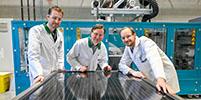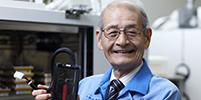Technologies to enable a sustainable energy transition
Last updated: 3.11.2022

The energy transition is by no means a linear process. Instead, it is made up of different phases that build upon each other. Even as the share of renewables in electricity production increases, renewable energy sources often remain intermittent. For example, there are only a limited number of hours of sunlight per day and inevitable down time at night. Wind strength varies too. All this means that supply and demand are not always aligned. In other words, sufficient energy storage and distribution systems are crucial to achieving a sustainable energy transition and reliably balancing supply and demand. While sufficient storage capacity is developed, carbon capture utilisation and storage can be used as an intermediate measure to collect the CO2 emissions generated for as long as fossil fuels continue to be burned.
Renewable electricity is expected to account for a large share of energy consumption in the EU by 2050, but not all of it. Hydrogen has the potential to help bridge the gap, including as a vector for renewable energy storage, alongside batteries. Renewables-based hydrogen can also be used as feedstock for the chemical sector and as fuel. It can provide a medium-term solution for certain regions or sectors that may otherwise be hard to decarbonise.
The integration of renewables into the global energy system requires improved control systems that can accommodate these inherently variable sources of energy. Smart grids can play an important role here. As for storage capacity for renewable electricity, according to the Sustainable Development Scenario of the International Energy Agency, close to 10 000 gigawatt-hours (GWh) of battery and other forms of energy storage will be required by 2040, compared with around 200 GWh in 2020. To address this challenge, considerable progress is needed to find ways of storing electricity in large quantities and at a price affordable to suppliers and consumers.
United Nations Sustainable Development Goals
Innovation in the field of enabling technologies mainly supports the following United Nations Sustainable Development Goals:
- Carbon capture utilisation and storage

Carbon capture utilisation and storage (CCUS) enables the capture of carbon dioxide (CO2) generated by combustion or industrial processes. This CO2 can either be used as a resource for manufacturing useful products or stored, instead of being emitted into the atmosphere. Storage locations include underground geological formations, such as depleted oil or gas wells, or salt caverns.
CCUS is an important enabling technology for achieving net-zero emissions. The retrofitting of existing facilities with CCUS equipment would enable a proportion of current energy supply chains and large-scale industrial processes to be maintained more sustainably. This would buy time for developing cleaner solutions.
Preventing emissions
Capturing CO2 directly at source prevents its emission into the atmosphere. The use of CCUS is foreseen in particular for fossil-fuel-based power plants and, for example, in hydrogen production processes that use fossil fuels ("blue" hydrogen).
Negative emissions
In certain scenarios, CCUS may even help to achieve "negative emissions":
- Direct Air Capture (DAC): Capturing CO2 directly from the air. However, that is challenging because the CO2 concentration in the air is low compared to other components such as oxygen and nitrogen.
- Bioenergy with carbon capture and storage (BECCS): Capturing CO2 from the combustion of plant-based biofuels. Biofuels are derived from plants that have already captured CO2 from the air via photosynthesis to grow. Upon the combustion of the plant-based biofuel, this CO2 would be re-captured and subsequently re-used or stored, resulting in negative emissions.
Re-using CO2
Captured CO2 can principally be re-used in one of two ways:
- Directly in greenhouses or in supercritical form for processes such as dry-cleaning and the decaffeination of coffee.
- As an ingredient for a new product such as a fuel, a chemical or a building material. Although there have been some major success stories here (including the one below), transforming CO2 into other chemicals is often challenging, as the molecule is relatively inert.
Storage
Captured CO2 that cannot be re-used must be stored, typically in locations such as depleted oil or gas wells. Since these have already proven capable of holding oil or gas for eons, they are generally considered safe for current storage purposes. The infrastructure tends already to be in place for injecting gas, since gas is often used for keeping an oil well pressurised. Alternatively, CO2 can be made to react with certain mineral deposits to form carbonate minerals, for example.
Discover inventors' stories
Christoph Gürtler and Walter Leitner
By harnessing green chemistry to boost sustainability, the chemists Christoph Gürtler and Walter Leitner have developed a technique for using CO2 as a building block for greener plastics.
Search patent information
Further inventions relating to carbon capture utilisation and storage can be found in the Y02 classification scheme for climate change mitigation technologies:
- Hydrogen

Hydrogen (H2) is considered a sustainable energy vector, or chemical carrier of energy, especially when generated using renewable energy sources such as solar, wind and hydropower.
A distinction is often drawn between "grey" hydrogen, "blue" hydrogen and "green" hydrogen:
- "Grey" hydrogen is produced using natural gas, usually via a "steam reforming" process that also generates CO2.
- "Blue" hydrogen is produced the same way, but more than 80% of the CO2 emissions are captured and stored rather than being released into the atmosphere.
- "Green hydrogen" is produced using renewable energy sources. This can be done by means of the electrolysis of water using solar, wind or hydropower as the electricity source.
When hydrogen is burnt as a direct fuel for the purposes of heating or providing mechanical energy (e.g. propulsion), it is converted into water. This means that, unlike with fossil fuels, no CO2 is produced. When hydrogen is used in a fuel cell, it is converted into water and electricity.
"Green" hydrogen is important for the energy transition in two main respects. Firstly, it could partially replace fossil fuels, for example in the transportation sector. Secondly, it can also be used to balance out supply and demand for renewable energy, which is a major issue. As such, green hydrogen offers a means of storing and transporting renewable energy at times when the production of renewable energy exceeds demand. In addition, green hydrogen can serve as an energy source when demand for renewable energy outstrips production.
Learn more
Read the joint study published by the EPO and the International Renewable Energy Agency (IRENA) on innovation trends for water electrolysers in hydrogen production.
Discover inventors' stories
Johan Martens, Tom Bosserez and Jan Rongé
These European Inventor Award finalists invented a solar panel that produces clean hydrogen gas from sunlight and ambient moisture. The panel is made using cheap and abundant materials, and could potentially provide an alternative source of green energy for buildings around the world.
Search patent information
Further solar energy inventions can be found in the Y02 classification scheme for climate change mitigation technologies:
Y02E60/30: Hydrogen technologies
- Smart grids: The future of electricity networks

The concept of a smart grid first officially emerged in the United States in 2007. Smart grids for electricity delivery comprise smart metering infrastructure, smart distribution boards, circuit breakers, renewable energy sources and energy storage systems.
These elements are interconnected and monitored using fibre broadband paired with a wireless backup system. The aim is to "cost-efficiently integrate the behaviour and actions of all users connected to it - generators, consumers and those that do both - in order to ensure economically efficient, sustainable power system with low losses and high levels of quality and security of supply and safety."
In Europe, the Smart Grids European Technology Platform oversees the latest developments in the field and brings together stakeholders, including policymakers, network operators, component suppliers and manufacturers, and researchers.
Traditional electrical grids in developed countries conventionally include large power plants that use high-voltage power lines to supply industrial and domestic users. However, the increased use of wind and solar power increases the need for improved control systems that can accommodate these inherently variable sources of energy.
As a result, data and information management play a central role in smart grids. Their advantages are manifold:
- Reliability: Thanks to technological advances in areas such as state estimation, fault detection is more accurate, enabling networks to self-heal
- Flexibility: Networks can handle bidirectional energy flow; network users can supply energy to the grid (generated by rooftop photovoltaic panels, for example); charge to and from batteries and fuel cells is enabled
- Efficiency: Smart grid technologies support demand-side management, real-time adjustments in energy distribution lines and lower energy prices
- Sustainability: Multiple distributed renewable energy sources can easily be connected to the grid, including at the transmission level
- Market-enabling: Communication between suppliers and consumers is systematic and continuous, enabling better decision-making when it comes to pricing strategies on the supplier side and energy consumption on the consumer side.
Discover inventors' stories
Gunnar Asplund
By boosting the efficiency of transmitting electricity from remote power stations, Gunnar Asplund’s high-voltage power grid connection can make renewable energy sources more viable.
Search patent information
Further solar energy inventions can be found in the Y02 classification scheme for climate change mitigation technologies:
- Batteries

Electricity storage is one of the key challenges for the energy transition from fossil fuels to renewable energy sources. By 2019, pumped hydropower accounted for 91% of the world's installed energy storage capacity, making it by far the most established technology in this area. However, between 2000 and 2018, nearly 90% of electricity storage patents related to battery technologies.
This patenting trend is chiefly driven by advances in the rechargeable lithium-ion ( Li-ion) batteries used in consumer electronic devices and electric cars. Electric mobility in particular is fostering innovation aimed at improving power output, durability, charge/discharge speed and recyclability. Further progress in battery innovation is required to integrate larger quantities of renewable energy, such as wind and solar power, into electricity networks.
Increasing the sustainability of Li-ion batteries means considering their entire life cycle, from the availability and processing of raw materials to battery design and manufacturing, to device application and end-of-life management. In contrast to recycling lead acid batteries, for example, the recycling of Li-ion batteries has yet to become well-established. Yet it is becoming more and more attractive because of the high value and limited availability of raw materials. This is another area in which patenting activity increased between 2000 and 2018.
An alternative to recycling batteries is re-using them in second-life applications. Batteries that no longer provide sufficient charge capacity to power electric cars can be reused in various ways, including for stationary energy storage.
Meanwhile, large -scale grid storage requires long life and low-cost batteries. There are multiple issues to consider here too: both cyclability (the number of times a battery can be charged during its lifetime) as well as calendar life; round-trip efficiency (the percentage of electricity put into storage that is later retrieved) as well as maintenance costs. Although Li-ion technology can be adapted for almost any use, it comes with high costs and certain safety concerns. These may present challenges to its use in larger installations.
Redox-flow batteries (RFBs), on the other hand, are a cost-effective means of stationary storage, particularly when it comes to long discharges, long storage times and high cyclability. This makes RFBs ideal for integration into renewable energy production and energy storage solutions. RFBs with mainly aqueous-based systems also enable very flexible scalability and large-scale storage.
Liquid metal batteries are able to retain 99% of their original capacity over 5 000 charging cycles because they do not suffer the structural damage that conventional batteries experience as charged atoms flow through them. As a result, they could reduce the cost of storing solar and wind power on the electricity grid, leading to a larger overall proportion of clean power being consumed during peak load times.
Learn more
Read Innovation in batteries and electricity storage - a global analysis based on patent data , one of several joint studies published by the EPO and the International Energy Agency.
Discover inventors' stories
Akira Yoshino
Japanese chemist Akira Yoshino is known as the “father of the lithium-ion battery.” Yoshino’s contribution to the field was recognised in 2019, when he won both the European Inventor Award in the category "Non-EPO countries" and, together with John B. Goodenough and M. Stanley Whittingham, the Nobel Prize in Chemistry.
Donald Sadoway
Comprised of locally sourced raw materials, his battery provides a cost-effective long-term storage solution. In 2022, Donald Sadoway won the European Inventor Award, also in the category "Non-EPO countries", for his work on liquid metal batteries for storing renewable energy.
Search patent information
Further inventions relating to batteries can be found in the Y02 classification scheme for climate change mitigation technologies:


